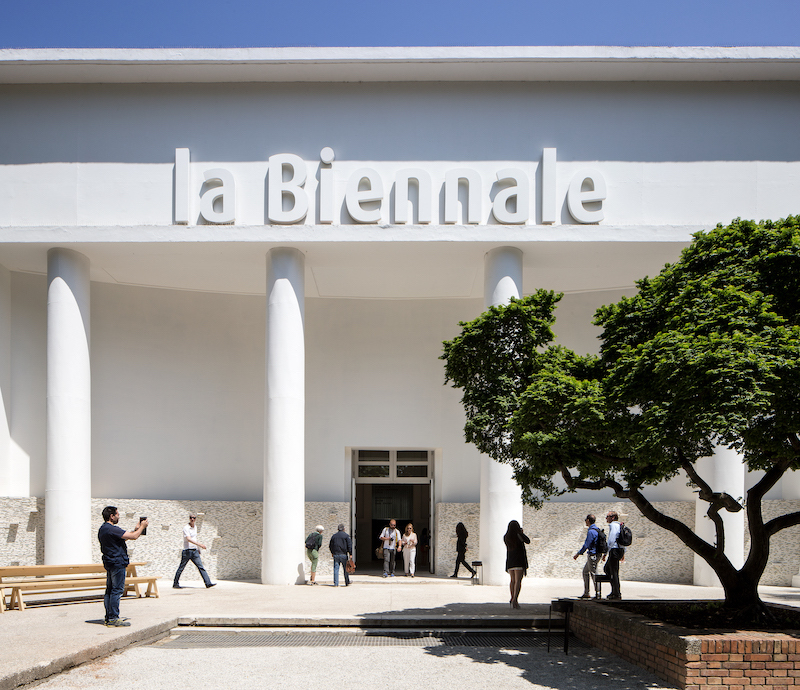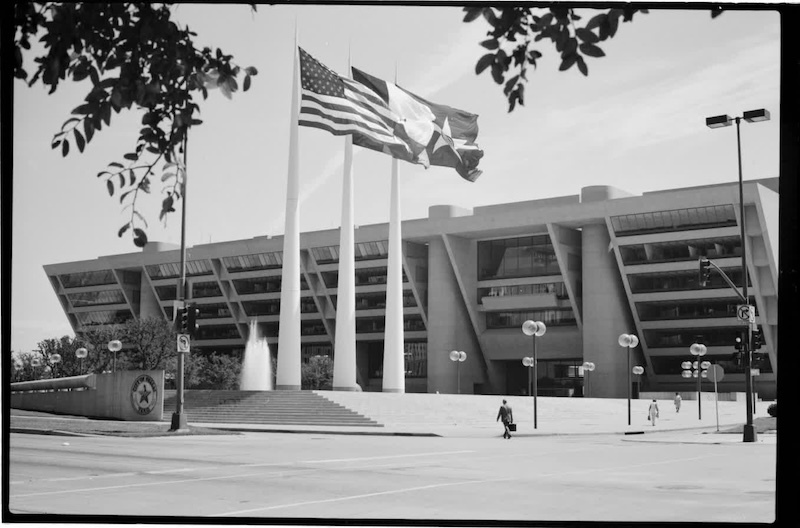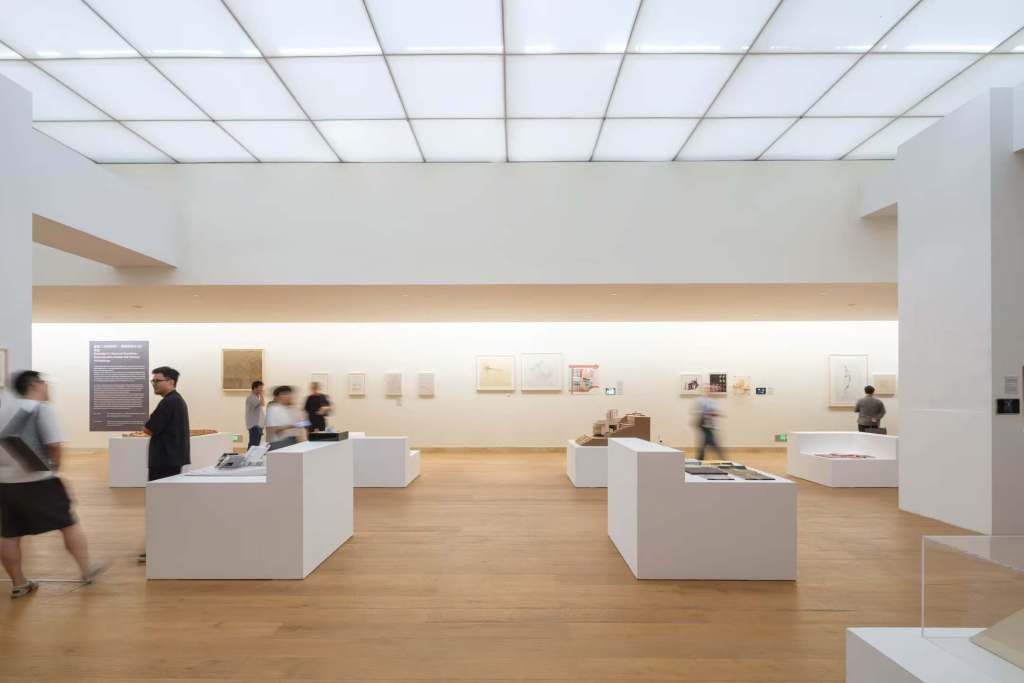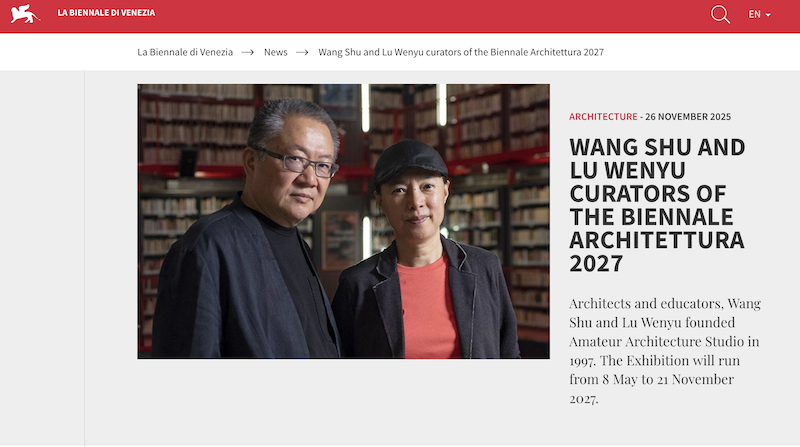
On May 10, the 19th Venice Architecture Biennale opened in Venice. The Biennale was curated by Italian architect Carlo Ratti, with the theme of "Intelligens. Natural. Artificial. Collective." It invited people to explore how architecture can respond to climate change.
In addition to the theme exhibition, this year's Biennale also includes exhibits from 66 countries, which present many Chinese cases and wisdom, such as Zhang Yonghe's "Langtou Experiment" telling the story of a 700-year-old Lingnan ancient village's transformation and rebirth, and OPEN Architecture's video installation project "Nature Trilogy" in which the UCCA Dune Art Museum, Valley Concert Hall, and Time Tower. The Chinese Pavilion of the Venice Architecture Biennale is curated by architect Ma Yansong. The theme of the exhibition is "Rong Wisdom", showing the philosophy of "harmony between man and nature" interpreted through architectural language.
The Venice Architecture Biennale has been held as an independent architectural exhibition since 1980. The first exhibition in 1980 was hosted by Italian architect and scholar Adalberto Libera. Initially, the Architecture Biennale focused on the setting and design of exhibition spaces, which was different from other types of art exhibitions. It started as an exploration of the field of architecture, and later gradually developed into a more systematic and international exhibition platform, covering many aspects such as architectural design, urban planning, and architectural theory.

Venice Architecture Biennale
Focus on "Intelligence·Natural·Artificial·Collective"
Venice itself is vulnerable to the impacts of climate change due to rising sea levels, so the Italian city provides a suitable backdrop for an international gathering of ideas, perspectives and solutions around this pressing issue. Under the planning of curator Carlo Ratti, the 19th Venice Architecture Biennale is themed "Intelligence·Natural·Artificial·Collective", focusing on the relationship between architecture and different disciplines such as cities, environment, technology, and energy, exploring how architecture should "intelligently" respond to environmental crises. At the same time, the Biennale also includes 66 national pavilions, including four countries participating for the first time: the Republic of Azerbaijan, the Sultanate of Oman, Qatar and Togo. According to published data, this Biennale is expected to become the largest architectural biennale ever held in Venice.

Venice International Architecture Biennale Arsenale Pavilion
Organizers hope to transform the Biennale into a dynamic laboratory, bringing together architects, engineers, mathematicians, scientists, climate scholars and other experts to present different perspectives on architecture's responsibility to adapt to a changing world.
Curator Carlo Ratti said, "Architecture has always been a response to harsh climates. From the earliest 'primitive huts', human design has been guided by the need for shelter and survival, driven by optimism: our creations have always sought to bridge the gap between the harsh environment and the safe, habitable spaces we need."

Curator Carlo Ratti
“Today, as the climate becomes more severe, this dynamic response reaches a new level. In the fires in Los Angeles, the floods in Valencia and Sherpur, and the drought in Sisli, we are witnessing water and fire attacking us with unprecedented intensity,” said Carlo Ratti. “For decades, the architecture community’s response to the climate crisis has focused on mitigation—designing to reduce our impact on the climate. But this approach is no longer enough. It’s time for architecture to embrace adaptability: to rethink how to design for a changed world—architecture must become as flexible and dynamic as the world we now design for.”

Venice Architecture Biennale theme exhibition site
Another important focus of the theme exhibition is the analysis of forms of artificial intelligence. The Biennale will show how artificial intelligence is used in urban planning, how it can help detect waste that can be used for reconstruction work, and how to transform cities into places for urban mining. The exhibition also explores Venice's unique relationship with water, focusing on water management and purification technologies. Installations, prototypes, and experiments throughout the Biennale venue turn Venice itself into a living laboratory, blending digital and physical spaces to encourage participation and collaboration.

Venice Architecture Biennale theme exhibition site
Regarding the theme of "Intelligence, Nature, Artificiality, Collectiveness", Buttafuoco, president of the Venice Biennale, once said in an interview with The Paper: The selection of curators and themes is based on a core direction: the future. The Biennale always tends to invite professionals who are representative on the international stage and who can better promote work in this direction. Through disciplines such as art, architecture, music, drama, dance and film, the Venice Biennale provides its curators with the possibility of writing a chapter on the future world, rather than repeating the past that has already happened.
Chinese Wisdom in the Biennale
Many Chinese cases were also presented in the theme exhibition of the Biennale. Among them, the "Langtou Experiment" was jointly presented by the architect Zhang Yonghe, Feichang Architecture, and Vipshop Charity. It uses a video documentary that records the development of the project over the past three years and a model made of environmentally friendly materials as a carrier to tell the story of a 700-year-old Lingnan ancient village's transformation and rebirth. Longtou Village was built in the late Southern Song Dynasty and has a history of more than 700 years. It is one of the only two "Chinese Historical and Cultural Villages" in Guangzhou. Since 2021, the relevant team has carried out protection and repair of the ancient village. Through the construction of Chunyangtai Art and Culture Center, Hechunzhu Cultural Country Villa, Sun Yongzhao Jimulou Ancient Village Permanent Exhibition, Xinhua China Immersive Light and Shadow Art Exhibition, Longnatou Grassland, Market Shops and other diversified cultural formats, efforts have been made to make culture burst out with real vitality in the countryside. In the exhibition, in addition to the narration of the model and the film, this project also presented the Longtou fish lantern with Lingnan cultural characteristics created by artist Wen Qiuwen, which was taken to the gondola in Venice for a cruise.

The Longtou Experiment Project
OPEN Architecture and director Zhang Nan presented the video installation project "Nature Trilogy". The video focuses on three architectural works completed by OPEN in recent years: UCCA Dune Art Museum, Valley Concert Hall, and Time Tower. Although these three buildings each respond to their own unique contexts, they share a common architectural concept: awe of nature, weather resistance in harsh environments, and response to celestial cycles. They are all committed to capturing invisible energy and bringing people a touching experience, helping people rediscover their innate perception and regain a sense of belonging in a real world that is increasingly divided by technology.

Video installation project "Nature Trilogy"
In addition to the main exhibition, the presentation of the China Pavilion is undoubtedly of great interest. The exhibition of the China National Pavilion is curated by architect Ma Yansong, and the theme of the exhibition is "Ren Wisdom". Ma Yansong said that for the Chinese, "nature" is not just the natural materials and technologies commonly understood today, or "environmentally friendly", but a worldview of harmony between man and nature, believing that man and the universe are actually one, and that there is a relationship of you in me and me in you. All things in nature therefore have human life, emotions and wisdom.
The China Pavilion hopes to reinterpret the philosophy of "harmony between man and nature" through architectural language, and explore how the emotional connection between man and nature can continue in a modern society dominated by technology. This is not only a response to the overall theme, but also an attempt to provide an oriental solution for the global architectural community.

Photo of the "Plug-in Renewal City" model (Source: People's Architecture)
Among them, the Zhongjian team cooperated with the Long Ying research group of the School of Architecture of Tsinghua University, taking the theme of "Plug-in Home" as the starting point, and re-imagined a new picture of future urban development. Since 2013, Zhongjian has developed the "Plug-in Home" system to address the long-standing imperfect infrastructure in old urban areas, suburbs and villages in various places, providing a set of systematic solutions including multiple functional modules for problems such as poor airtightness, insulation, sound insulation and moisture resistance of houses.

Jingshan Park, still frame from the video "Spring on Beijing's Central Axis" (Photo credit: Dune Research Institute)
The Dune Research Institute presented the video work "Spring on the Central Axis of Beijing". The work selected Jingshan, Bell and Drum Tower, Qianmen and other nodes on the 7.8-kilometer central axis of Beijing, and used cutting-edge technology to make them present a sense of "contemporary landscape".
Facing the pressing challenges of our time
At the Biennale, the Italian National Pavilion looks to the Mediterranean and surrounding seas, not as a border, but as a positive factor in shaping the transformation of culture, architecture and climate awareness. The cases in the pavilion propose new architectural methods for coastal cities and fragile ecosystems facing the pressure of rising sea levels and environmental changes; the German Pavilion launched the "STRESSTEST: Adapting to Extreme Heat" exhibition, which explores the growing threat of climate-induced overheating. This pavilion brings together expertise in architecture, urban planning and environmental research to explore how rising temperatures reshape the lives of humans, animals, plants and cities.

German Pavilion Exhibition Works
The Austrian Pavilion launched the "Better Living Institutions" exhibition, which addresses issues such as housing and future life; the theme of the Belgian Pavilion is "Building the Biosphere", exploring the potential of plant intelligence in shaping future architecture. The exhibition delves into how architecture can be combined with plants in a way that promotes sustainability and livability. The project envisions a more sustainable urban space that can better cope with climate change and urban heat islands.

Austrian Pavilion Exhibition Works

Exhibition works of the Belgian Pavilion
The Brazilian Pavilion’s exhibition, themed “(RE)Innovation,” examines the intersection between ancestral knowledge and contemporary urban infrastructure, reflecting recent archaeological discoveries in the Amazon region to rethink the socio-environmental challenges of modern cities; the Albanian Pavilion’s exhibition explores the evolving relationship between architecture and society, reflecting Albania’s cultural and urban transformation.
The Spanish Pavilion’s “Interiority” explores the intersection between architecture, environment and sustainability. The exhibition highlights how architecture can balance ecology and economy through projects that incorporate local, renewable and low-carbon materials such as wood, stone, cork, clay and plant-based fibres.

Brazil Pavilion

Spanish Pavilion
Sensory experience at the exhibition
In the Biennale, many pavilions’ exhibitions emphasize sensory experience. For example, the Australian Pavilion exhibits the “Home” exhibition designed by an Aboriginal design team. This is an immersive sensory-driven exhibition that promotes dialogue between Aboriginal and non-Aboriginal communities on the global stage through participatory design, celebrating Australia’s natural environment and Aboriginal knowledge systems.

Australia Pavilion
The Luxembourg Pavilion presents a sonic exploration that repositions architectural discourse as hearing, studies the sonic landscape within Luxembourg, and invites visitors to experience architecture through immersive listening; the Swiss Pavilion hosts the exhibition "The Final Form is Determined by the On-Site Architect", which reimagines the pavilion through the perspective of pioneering female architect Lisbet Sachs to explore the role of women in architectural history and the evolving concept of inclusion in design. The exhibition interweaves the soundscape produced by on-site recordings with site-specific interactions to provide visitors with an immersive sensory experience.

Qatar Pavilion
The Turkish Pavilion, with the theme of "Roots", delves into the role of soil as an ecological and cultural archive. It emphasizes the role of soil as a living entity, an ecosystem, and a source of memory and knowledge. Through sensory experiences, scientific literature, and interdisciplinary works, it explores how soil connects past civilizations with future sustainable practices and combines traditional building methods with innovative research. Also focusing on soil is the Lebanese Pavilion. The pavilion launched the "Memory of the Land" project, positioning architecture as a tool for environmental resistance.

The “Margherissima” project
It is reported that there are 11 official side events of the Venice Architecture Biennale, which are hosted by international non-profit organizations and span different locations in Venice, bringing a new, interdisciplinary perspective to the evolving role of architecture in society. Among them, the Architectural Association and Nigel Coates jointly launched "Margherissima" - a complete transformation of Venice's industrial suburbs into a thriving collective community to serve future climate-conscious citizens. The installation transforms a polluted site into a walkable city model, hanging on a 12-meter-high light box, and is vividly presented to people through video, projection and 1:250 scale complex architectural models, combining industrial waste, household objects, and handmade elements such as glass, ceramics and bronze, which are lit in a cycle that simulates the passage of time.

"Water Parliament: Projective Eco-Social Architecture"
The exhibition "Water Parliament: Projective Eco-Social Architecture" explores the transformative potential of water in shaping future architecture and environmental governance. It studies how to integrate water into urban design, from materials and infrastructure to large-scale landscape interventions. Focusing on Catalonia, the Balearics and Valencia, the exhibition emphasizes that water is a core element of architecture, politics and ecological responsibility, calling for a collective reflection on the future of water governance and urban development.
The 2025 Venice Architecture Biennale will respond to the challenges faced by humanity through a cross-border architectural experiment, and build a global dialogue field to address issues such as the climate crisis and technological ethics.
The exhibition will run until November 23rd.
(This article is compiled from the official website of the Venice Architecture Biennale, ArchDaily and previous reports from The Paper)


